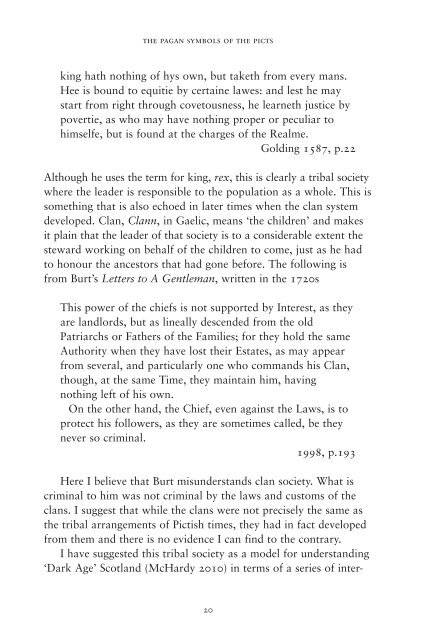Pagan Symbols of the Picts by Stuart McHardy sampler
Stuart McHardy examines the Pictish symbols which have been discovered on various items across Scotland. The book sets out a cohesive interpretation of the Pictish past, using a variety of both temporal and geographical sources. This interpretation serves as a backdrop for his analysis of the symbols themselves, providing a context for his suggestion that there was an underlying series of ideas and beliefs behind the creation of the symbols.
Stuart McHardy examines the Pictish symbols which have been discovered on various items across Scotland. The book sets out a cohesive interpretation of the Pictish past, using a variety of both temporal and geographical sources. This interpretation serves as a backdrop for his analysis of the symbols themselves, providing a context for his suggestion that there was an underlying series of ideas and beliefs behind the creation of the symbols.
You also want an ePaper? Increase the reach of your titles
YUMPU automatically turns print PDFs into web optimized ePapers that Google loves.
<strong>the</strong> pagan symbols <strong>of</strong> <strong>the</strong> picts<br />
king hath nothing <strong>of</strong> hys own, but taketh from every mans.<br />
Hee is bound to equitie <strong>by</strong> certaine lawes: and lest he may<br />
start from right through covetousness, he learneth justice <strong>by</strong><br />
povertie, as who may have nothing proper or peculiar to<br />
himselfe, but is found at <strong>the</strong> charges <strong>of</strong> <strong>the</strong> Realme.<br />
Golding 1587, p.22<br />
Although he uses <strong>the</strong> term for king, rex, this is clearly a tribal society<br />
where <strong>the</strong> leader is responsible to <strong>the</strong> population as a whole. This is<br />
something that is also echoed in later times when <strong>the</strong> clan system<br />
developed. Clan, Clann, in Gaelic, means ‘<strong>the</strong> children’ and makes<br />
it plain that <strong>the</strong> leader <strong>of</strong> that society is to a considerable extent <strong>the</strong><br />
steward working on behalf <strong>of</strong> <strong>the</strong> children to come, just as he had<br />
to honour <strong>the</strong> ancestors that had gone before. The following is<br />
from Burt’s Letters to A Gentleman, written in <strong>the</strong> 1720s<br />
This power <strong>of</strong> <strong>the</strong> chiefs is not supported <strong>by</strong> Interest, as <strong>the</strong>y<br />
are landlords, but as lineally descended from <strong>the</strong> old<br />
Patriarchs or Fa<strong>the</strong>rs <strong>of</strong> <strong>the</strong> Families; for <strong>the</strong>y hold <strong>the</strong> same<br />
Authority when <strong>the</strong>y have lost <strong>the</strong>ir Estates, as may appear<br />
from several, and part i cularly one who commands his Clan,<br />
though, at <strong>the</strong> same Time, <strong>the</strong>y maintain him, having<br />
nothing left <strong>of</strong> his own.<br />
On <strong>the</strong> o<strong>the</strong>r hand, <strong>the</strong> Chief, even against <strong>the</strong> Laws, is to<br />
protect his followers, as <strong>the</strong>y are sometimes called, be <strong>the</strong>y<br />
never so criminal.<br />
1998, p.193<br />
Here I believe that Burt misunderstands clan society. What is<br />
criminal to him was not criminal <strong>by</strong> <strong>the</strong> laws and customs <strong>of</strong> <strong>the</strong><br />
clans. I suggest that while <strong>the</strong> clans were not precisely <strong>the</strong> same as<br />
<strong>the</strong> tribal arrangements <strong>of</strong> Pictish times, <strong>the</strong>y had in fact developed<br />
from <strong>the</strong>m and <strong>the</strong>re is no evidence I can find to <strong>the</strong> contrary.<br />
I have suggested this tribal society as a model for understanding<br />
‘Dark Age’ Scotland (<strong>McHardy</strong> 2010) in terms <strong>of</strong> a series <strong>of</strong> inter-<br />
20


















